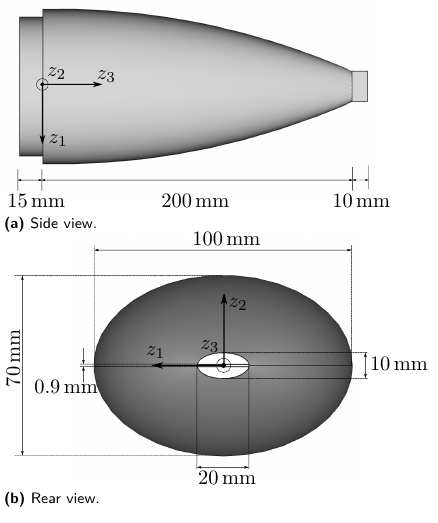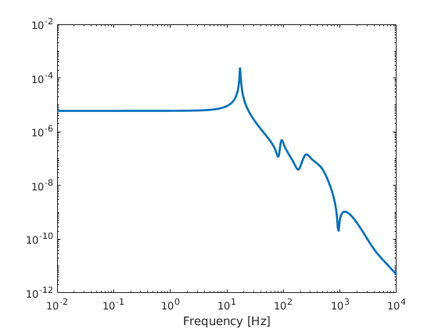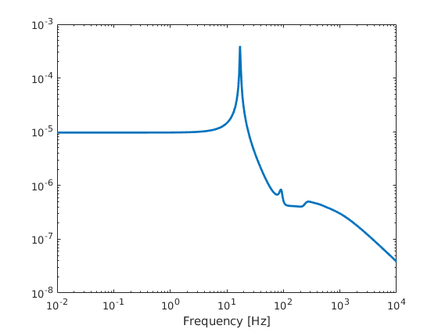| Line 8: | Line 8: | ||
<figure id="fig:plot1"> |
<figure id="fig:plot1"> |
||
| − | [[File:Fishtail.png| |
+ | [[File:Fishtail.png|4380px|thumb|right|<caption>Schematic 3D-Model-Fishtail</caption>]] |
</figure> |
</figure> |
||
<figure id="fig:plot2"> |
<figure id="fig:plot2"> |
||
| − | [[File:fishtail_tf.png| |
+ | [[File:fishtail_tf.png|438px|thumb|right|<caption>Bode Magnitude Plot Fishtail Cp</caption>]] |
</figure> |
</figure> |
||
<figure id="fig:plot3"> |
<figure id="fig:plot3"> |
||
| − | [[File:fishtail_ext_tf.png| |
+ | [[File:fishtail_ext_tf.png|438px|thumb|right|<caption>Bode Magnitude Plot Fishtail Cp_ext</caption>]] |
</figure> |
</figure> |
||
Revision as of 07:15, 15 February 2019
 Note: This page has not been verified by our editors.
Note: This page has not been verified by our editors.
Description
Todays autonomous underwater vehicles (AUVs) are subject to noise pollution and inefficiency due to their screw propeller driven design. The evolution of fish has, on the other hand, optimized their underwater efficiency and agility over millennia. The adaption of fish-like drive systems for AUVs is therefore an obvious choice.
Model Description
This model describes the silicon body of an artificial fishtail supported by a central carbon beam. The rear part of the fish-body without the fins is modeled as as a 3d FEM model using linear elasticity. In the current stage of modeling the tail is rigidly mounted in the front, the states in  represent the displacements of the finite element degrees of freedom. The fish-like locomotion is enabled by pumping air between two sets of pressure chambers in the left and right halves of the tail. The single input
represent the displacements of the finite element degrees of freedom. The fish-like locomotion is enabled by pumping air between two sets of pressure chambers in the left and right halves of the tail. The single input  of the system is thus the pumping pressure. The outputs are displacements of certain surface points. There are two variants of the model. The first has only three outputs representing the displacements of the point of interest, the rear tip of the carbon beam, in the three spatial directions. For the second variant 6 additional points on the flank are added as outputs.
of the system is thus the pumping pressure. The outputs are displacements of certain surface points. There are two variants of the model. The first has only three outputs representing the displacements of the point of interest, the rear tip of the carbon beam, in the three spatial directions. For the second variant 6 additional points on the flank are added as outputs.

|

|

|
|---|---|---|
| 0.05 | 0.0 | 0.0 |
| 0.0474526 | 0.0 | 0.0599584 |
| 0.04032111 | 0.0 | 0.105274 |
| 0.0326229 | 0.0 | 0.136726 |
| 0.0250675 | 0.0 | 0.16107 |
| 0.0168069 | 0.0 | 0.183588 |
| 0.0 | 0.0 | 0.21 |
Note that the POI is the last row in this table and in Cp_ext in the data files (see below). The additional outputs show two effects. On the one hand, for purely input output related reduction methods they avoid drastic deviations on the interior states. on the other hand they show a smoothing effect for the models transfer function.
Origin
The model was setup and computed at the chair of automatic control at CAU Kiel and first presented in [1].
Data
Based on the the finite element package Firedrake and using the material parameters
| Part | Parameter | Value | Unit |

|

|

| |
| Hull | 
|

|

|

|

|
||

|

|

| |
| Beam | 
|

|

|

|

|
||
| Rayleigh damping | 
|

|

|

|

|

|
Dimensions
System structure:
System dimensions:
 ,
,
 ,
,
 ,
,
 ,
,
 ,
with
,
with  and
and  .
.
The internal damping is modeled as Rayleigh damping  using the coefficients from the table above.
using the coefficients from the table above.
System variants:
 :
:  Cp in the data files,
Cp in the data files, :
:  Cp_ext in the data files.
Cp_ext in the data files.
Citation
To cite this benchmark, use the following references:
- For the benchmark itself and its data:
@Misc{SieKM19,
author = {Siebelts, D. and Kater, A. and Meurer, T.},
title = {Matrices for an Artificial Fishtail},
howpublished = {hosted at {MORwiki} -- Model Order Reduction Wiki},
month = feb,
year = 2019,
doi = {10.5281/zenodo.2558728}
}
- For the background on the benchmark:
@Article{SieKM18,
author = {Siebelts, D. and Kater, A. and Meurer, T.},
title = {Modeling and Motion Planning for an Artificial Fishtail},
journal = {IFAC-PapersOnLine},
year = 2018,
volume = 51,
number = 2,
pages = {319--324},
doi = {10.1016/j.ifacol.2018.03.055},
publisher = {Elsevier {BV}}
}
References
- ↑ D. Siebelts, A. Kater, T. Meurer, Modeling and motion planning for an artificial fishtail, IFAC-PapersOnLine 51 (2) (2018) 319–324.




